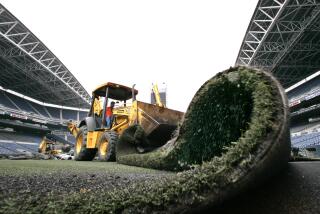Absorbing Issue : Polymers Are Saving Grace for Large Water Users, but Some Question Long-Term Effects
- Share via
DANA POINT — They are an unlikely savior, resembling a handful of coarse salt rather than an effective means of water conservation.
For years, gardeners have mixed the tiny water-absorbing polymer crystals with soil as a way of keeping the earth moist between waterings. But in the deepening water crisis gripping Southern California, polymers--which are capable of absorbing up to 450 times their weight in water--are enjoying a surge in popularity.
More than a million polymer packets have been distributed to consumers by the Metropolitan Water District. And with the recent introduction of machines that sow polymers under several acres of lawn at a time, large water users such as hotels, golf courses and cities are claiming water savings of 30% to 50%.
“It’s an amazing product,” said Bill Raymond, public works superintendent for the city of Cypress, which uses polymers beneath lawns in local parks and ball fields. ‘The only negative about it is that it isn’t free.”
Polymer acrylamides, synthetic crystals with immense water absorbing properties, can retain liquid for more than a month and function for years, horticulture experts say. A half-teaspoon of polymer granules dropped into a glass of water will absorb the liquid in minutes, swelling into a clear, gelatin-like substance resembling miniature ice cubes.
The federal Environmental Protection Agency and private sector researchers say the polymers are perfectly safe, though some environmentalists caution that long-term studies of the chemical have not yet been completed.
For landscapers, the polymers have meant big water savings. In Fountain Valley’s Mile Square Park, head groundskeeper Charlie Walther gave polymer acrylamides the stiffest test he could think of.
“We set aside 10 acres of grass for parking for our annual July 4 celebration, and during that time, we shut the water down completely in that spot,” he said. “We sowed a section of the parking area with polymers and that section stays a lot greener. The difference is pretty vivid.”
At the Ritz Carlton in Dana Point, the use of polymers resulted in the hotel’s water consumption for landscaping dropping by 30%.
“We returned our net cost ($2,000 for sowing polymers beneath 3 acres of turf) in two months,” said Steve Herrera, the hotel’s director of engineering. “Since then, our local water district has come to us and asked how we achieved these savings.”
First patented by Monsanto in 1963, polymers are strings of large molecules that chemists use like Tinker Toys, adding, subtracting or linking them together to create diverse uses ranging from filling for disposable diapers to dental products. Water-absorbing polymers have been around for about 10 years.
Sown under the lawn, the polymers act as a mini-reservoir. Water is trapped beneath the ground instead of percolating through the soil or evaporating. Roots eventually grow into the water-swollen polymers and use the water stores until they are exhausted. The polymer reverts back to granule form until the next watering and can be reused for five to 10 years, according to industry representatives.
Manufacturers say their product is nontoxic and environmentally safe, claims that are supported by several university researchers who are currently conducting studies on polymer acrylamides.
However, independent, long-term studies on how well polymers biodegrade are yet to be conducted.
“I really have to question the production of a synthetic product to incorporate into the soil for several years,” said Susan Cooper, staff ecologist for the National Coalition Against the Misuse of Pesticides, a Washington-based private nonprofit group. “What will happen to the soil 10 years down the road? Long-range studies need to be done to answer that question.”
The technology needed to sow them under the ground has been refined only in the last year for popular use.
Machines have been developed that are capable of cutting sod, lifting it to allow the polymer grains to be blown underneath and replacing the turf without damaging the root systems. Landscapers interviewed charge an average of $750 per acre for large jobs such as parks or golf courses and about $100 per 1,000 square feet of residential lawn.
However, some polymer makers say the current crop of machines do a poor job and warn consumers to make sure their landscaper has experience in polymer lawn installation and can give references.
“I haven’t been at all satisfied with the equipment out there,” said Dean Piper, vice president of research for Broadleaf Industries in San Diego, maker of a popular brand of polymers. “I don’t feel they are able to get the polymers down deep enough.”
Polymer industry officials say business has been improving because of the worsening effects of California’s drought this year.
Hydro Resources Southwest of Mesa, Ariz., sells polymers and the machines that sow them into the ground. Ron Salestrom, national sales manager for the firm, said he sold seven machines last year. In the last few weeks since the Metropolitan Water District announced mandatory cutbacks in January, Salestrom estimates that about 30 to 40 machines have been purchased by California landscapers.
“With your recent water crunch in California,” Salestrom said, “my phone has been ringing off the hook.”
DROUGHT BUSTERS
Polymer acrylamides are becoming a popular way for landscapers and gardeners to beat the drought. The tiny synthetic crystals absorb hundreds of times their own weight in water.
SOWING POLYMERS: For years, gardeners have dropped polymers into planting holes to supply plants with a water source. Only recently have machines been able to sow polymers beneath established lawns. It takes about 30 pounds of polymers to seed 1,000 feet of lawn, at a cost of about $100.
AMAZING ABSORBERS: When watered, polymer granules swell into a clear, gelatin-like substance that looks like crushed ice. They can absorb up to 450% of their weight in water and retain the liquid for more than a month. Landscapers say they reduce watering by 30% to 50%.
TINY RESERVOIRS: The polymer grains act as mini-reservoirs under the ground. They trap water that would otherwise be lost by percolating through the soil or evaporating. Roots eventually grow into the swollen polymers and use up their stored water.
REUSABLE FOR YEARS: The polymers eventually revert to crystal form. They are effective for five to 10 years, eventually breaking down into harmless elements, according to the EPA and researchers. However, some environmentalists are concerned about the long-term effects of polymer use.
More to Read
Inside the business of entertainment
The Wide Shot brings you news, analysis and insights on everything from streaming wars to production — and what it all means for the future.
You may occasionally receive promotional content from the Los Angeles Times.










